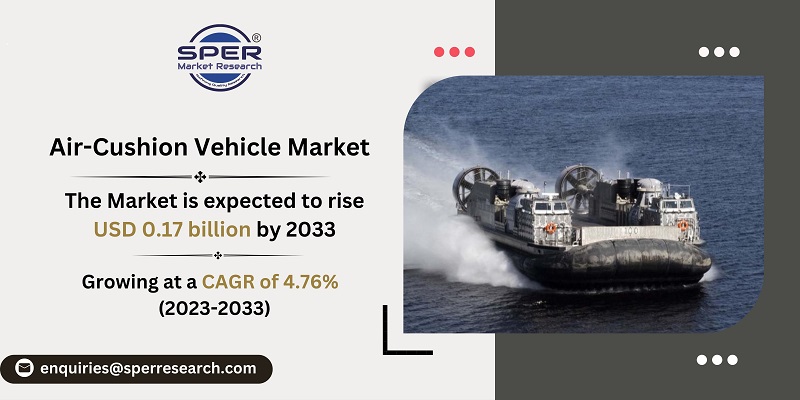
Air-Cushion Vehicle Market Growth, Trends, Size, Revenue, Scope, Challenges and Future Outlook
Air-Cushion Vehicle Market Size- By Type, By Application- Regional Outlook, Competitive Strategies and Segment Forecast to 2033
| Published: Jul-2023 | Report ID: AMIN23119 | Pages: 1 - 234 | Formats*: |
| Category : Automotive & Transportation | |||
- Versatility: They can go across land, water, ice, and marshy terrain, provide mobility solution. Because of their adaptability, they can move across difficult terrain where other vehicles might have trouble.
- Environmental Sustainability: More environmentally friendly transportation option in light of increased worries about carbon emissions and environmental impact. automobiles with air cushions have less friction and use less fuel than traditional automobiles, which reduces carbon emissions. They also have the benefit of functioning in environmentally delicate places without seriously harming the environment.


| Report Metric | Details |
| Market size available for years | 2019-2033 |
| Base year considered | 2022 |
| Forecast period | 2023-2033 |
| Segments covered | By Type, By Application. |
| Regions covered | Asia Pacific, Europe, Middle East and Africa, North America, Latin America |
| Companies Covered | Aerohod, ALMAZ, China Hovercraft Ltd, Christy Hovercraft, Griffon Hoverwork, Hoverstream, Hovertechnics, Jedy Hovercraft, Mariah Hovercraft, Mercier-Jones, Neoteric Hovercraft, The British Hovercraft Company, Vanair Hovercraft, Viper Hovercraft. |
- Defence and Military Organizations
- Emergency Services and Disaster Management Agencies
- Government Agencies and Law Enforcement
- Oil and Gas Industry
- Research and Exploration Organizations
- Tourism and Recreation Industry
- Transportation and Logistics Companies
- Others
| By Type: |
|
| By Application : |
|
- Global Air-Cushion Vehicle Market Size (FY’2023-FY’2033)
- Overview of Global Air-Cushion Vehicle Market
- Segmentation of Global Air-Cushion Vehicle Market By Type (Sidewall Air-cushion Vehicles, Skirted Air-cushion Vehicles.)
- Segmentation of Global Air-Cushion Vehicle Market By Application (Recreational, Rescue, Commercial, Military)
- Statistical Snap of Global Air-Cushion Vehicle Market
- Expansion Analysis of Global Air-Cushion Vehicle Market
- Problems and Obstacles in Global Air-Cushion Vehicle Market
- Competitive Landscape in the Global Air-Cushion Vehicle Market
- Impact of COVID-19 and Demonetization on Global Air-Cushion Vehicle Market
- Details on Current Investment in Global Air-Cushion Vehicle Market
- Competitive Analysis of Global Air-Cushion Vehicle Market
- Prominent Players in the Global Air-Cushion Vehicle Market
- SWOT Analysis of Global Air-Cushion Vehicle Market
- Global Air-Cushion Vehicle Market Future Outlook and Projections (FY’2023-FY’2033)
- Recommendations from Analyst
1.1. Scope of the report1.2. Market segment analysis
2.1. Research data source2.1.1. Secondary Data2.1.2. Primary Data2.1.3. SPER’s internal database2.1.4. Premium insight from KOL’s2.2. Market size estimation2.2.1. Top-down and Bottom-up approach
2.3. Data triangulation
4.1. Driver, Restraint, Opportunity and Challenges analysis4.1.1. Drivers4.1.2. Restraints4.1.3. Opportunities4.1.4. Challenges4.2. COVID-19 Impacts of the Global Air-Cushion Vehicle Market
5.1. SWOT Analysis5.1.1. Strengths5.1.2. Weaknesses5.1.3. Opportunities5.1.4. Threats5.2. PESTEL Analysis5.2.1. Political Landscape5.2.2. Economic Landscape5.2.3. Social Landscape5.2.4. Technological Landscape5.2.5. Environmental Landscape5.2.6. Legal Landscape5.3. PORTER’s Five Forces5.3.1. Bargaining power of suppliers5.3.2. Bargaining power of buyers5.3.3. Threat of Substitute5.3.4. Threat of new entrant5.3.5. Competitive rivalry5.4. Heat Map Analysis
6.1. Global Air-Cushion Vehicle Market Manufacturing Base Distribution, Sales Area, Product Type6.2. Mergers & Acquisitions, Partnerships, Product Launch, and Collaboration in Global Air-Cushion Vehicle Market
7.1. Global Air-Cushion Vehicle Market Value Share and Forecast, By Type, 2023-20337.2. Sidewall Air-cushion Vehicles7.3. Skirted Air-cushion Vehicles
8.1. Global Air-Cushion Vehicle Market Value Share and Forecast, By Application, 2023-20338.2. Recreational8.3. Rescue8.4. Commercial8.5. Military
9.1. Global Air-Cushion Vehicle Market Size and Market Share
10.1. Global Air-Cushion Vehicle Market Size and Market Share By Type (2019-2026)10.2. Global Air-Cushion Vehicle Market Size and Market Share By Type (2027-2033)
11.1. Global Air-Cushion Vehicle Market Size and Market Share By Application (2019-2026)11.2. Global Air-Cushion Vehicle Market Size and Market Share By Application (2027-2033)
12.1. Global Air-Cushion Vehicle Market Size and Market Share By Region (2019-2026)12.2. Global Air-Cushion Vehicle Market Size and Market Share By Region (2027-2033)12.3. Asia-Pacific12.3.1. Australia12.3.2. China12.3.3. India12.3.4. Japan12.3.5. South Korea12.3.6. Rest of Asia-Pacific12.4. Europe12.4.1. France12.4.2. Germany12.4.3. Italy12.4.4. Spain12.4.5. United Kingdom
12.4.6. Rest of Europe
12.5. Middle East and Africa12.5.1. Kingdom of Saudi Arabia12.5.2. United Arab Emirates12.5.3. Rest of Middle East & Africa12.6. North America12.6.1. Canada12.6.2. Mexico12.6.3. United States12.7. Latin America12.7.1. Argentina12.7.2. Brazil12.7.3. Rest of Latin America
13.1. Aerohod13.1.1. Company details13.1.2. Financial outlook13.1.3. Product summary13.1.4. Recent developments13.2. ALMAZ13.2.1. Company details13.2.2. Financial outlook13.2.3. Product summary13.2.4. Recent developments13.3. China Hovercraft Ltd13.3.1. Company details13.3.2. Financial outlook13.3.3. Product summary13.3.4. Recent developments13.4. Christy Hovercraft13.4.1. Company details13.4.2. Financial outlook13.4.3. Product summary13.4.4. Recent developments13.5. Griffon Hoverwork13.5.1. Company details13.5.2. Financial outlook13.5.3. Product summary13.5.4. Recent developments13.6. Hoverstream13.6.1. Company details13.6.2. Financial outlook13.6.3. Product summary13.6.4. Recent developments13.7. Hovertechnics13.7.1. Company details13.7.2. Financial outlook13.7.3. Product summary13.7.4. Recent developments13.8. Jedy Hovercraft13.8.1. Company details13.8.2. Financial outlook13.8.3. Product summary13.8.4. Recent developments13.9. Mariah Hovercraft13.9.1. Company details13.9.2. Financial outlook13.9.3. Product summary13.9.4. Recent developments13.10. Mercier-Jones13.10.1. Company details13.10.2. Financial outlook13.10.3. Product summary13.10.4. Recent developments13.11. Neoteric Hovercraft13.11.1. Company details13.11.2. Financial outlook13.11.3. Product summary13.11.4. Recent developments13.12. The British Hovercraft Company13.12.1. Company details13.12.2. Financial outlook13.12.3. Product summary13.12.4. Recent developments13.13. Vanair Hovercraft13.13.1. Company details13.13.2. Financial outlook13.13.3. Product summary13.13.4. Recent developments13.14. Viper Hovercraft13.14.1. Company details13.14.2. Financial outlook13.14.3. Product summary13.14.4. Recent developments
SPER Market Research’s methodology uses great emphasis on primary research to ensure that the market intelligence insights are up to date, reliable and accurate. Primary interviews are done with players involved in each phase of a supply chain to analyze the market forecasting. The secondary research method is used to help you fully understand how the future markets and the spending patterns look likes.
The report is based on in-depth qualitative and quantitative analysis of the Product Market. The quantitative analysis involves the application of various projection and sampling techniques. The qualitative analysis involves primary interviews, surveys, and vendor briefings. The data gathered as a result of these processes are validated through experts opinion. Our research methodology entails an ideal mixture of primary and secondary initiatives.



Frequently Asked Questions About This Report
PLACE AN ORDER
Year End Discount
Sample Report
Pre-Purchase Inquiry
NEED CUSTOMIZATION?
Request CustomizationCALL OR EMAIL US
100% Secure Payment






Related Reports
Our Global Clients
Our data-driven insights have influenced the strategy of 200+ reputed companies across the globe.




















